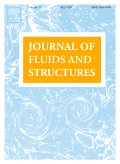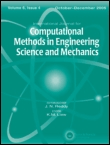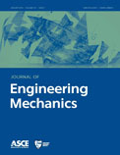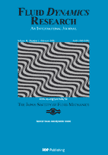
JOURNAL OF FLUIDS AND STRUCTURES
Scope & Guideline
Innovative Insights into Fluid Dynamics and Structural Mechanics
Introduction
Aims and Scopes
- Fluid-Structure Interaction (FSI):
The journal extensively covers research on fluid-structure interactions, exploring how fluid flows affect structural integrity and behavior, and vice versa. This includes studies on vortex-induced vibrations, flutter, and other dynamic responses of structures in fluid environments. - Numerical and Experimental Methods:
A significant focus is placed on both numerical simulations and experimental investigations. The journal publishes studies employing computational fluid dynamics (CFD), finite element analysis (FEA), and other advanced modeling techniques to address complex fluid-structure problems. - Hydrodynamic and Aerodynamic Studies:
Research related to hydrodynamics and aerodynamics is central to the journal's scope. This includes investigations into the forces exerted by fluids on structures, the behavior of fluid flows around various geometries, and the implications for design and engineering applications. - Innovative Applications and Technologies:
The journal highlights innovative applications of fluid-structure interaction research, including energy harvesting, design optimization of structures, and the development of new materials and technologies that enhance performance in fluid environments. - Multiscale and Multifunctional Approaches:
Research that integrates multiple scales and functionalities, such as microfluidics and bio-inspired designs, is encouraged. This reflects the journal's commitment to addressing modern challenges through interdisciplinary and multifaceted approaches.
Trending and Emerging
- Machine Learning and Data-Driven Approaches:
There is a notable increase in the use of machine learning and data-driven methodologies for predicting fluid-structure interactions and optimizing designs. This trend signifies a growing interest in leveraging computational intelligence to enhance predictive capabilities in fluid dynamics. - Bio-Inspired Designs and Applications:
Research inspired by biological systems, particularly in the design of flexible structures and mechanisms, is on the rise. This includes studies on the hydrodynamics of swimming organisms and the application of these principles to engineering solutions. - Energy Harvesting from Fluid-Induced Vibrations:
The journal is witnessing a surge in studies focused on energy harvesting mechanisms derived from fluid-induced vibrations. This reflects a broader interest in sustainable technologies and the potential for capturing energy from dynamic fluid environments. - Complex Systems and Multiphase Flows:
Emerging research on complex systems involving multiphase flows and their interactions with structures is becoming increasingly prominent. This includes investigations into sloshing dynamics, sediment transport, and the behavior of non-Newtonian fluids. - Adaptive and Smart Materials:
The use of adaptive and smart materials in fluid-structure interaction studies is trending. Research on materials that can change their properties in response to fluid dynamics is gaining attention, particularly for applications in aerospace and marine engineering.
Declining or Waning
- Traditional Fluid Dynamics without Structural Consideration:
There appears to be a waning interest in studies that focus solely on classical fluid dynamics without considering structural implications. As the field evolves, researchers are increasingly integrating structural analysis into fluid dynamics studies. - Low Reynolds Number Studies:
Research focused on low Reynolds number flows, while still important, is less frequently featured compared to studies on high Reynolds number effects, particularly in applications relevant to aerospace and large-scale engineering. - Static Stability Analysis:
The emphasis on static stability analysis of structures in fluid environments is decreasing. More dynamic and complex analyses, such as those involving time-varying flows and adaptive structures, are becoming more prevalent.
Similar Journals

ACTA MECHANICA SINICA
Fostering Innovation in Mechanical and Computational MechanicsACTA MECHANICA SINICA is a prestigious journal published by SPRINGER HEIDELBERG that has been a cornerstone in the field of mechanical engineering and computational mechanics since its inception in 1985. Based in Germany, this leading publication is internationally recognized for its high impact, holding a Q1 ranking in both Computational Mechanics and Mechanical Engineering as of 2023. It is positioned prominently within the academic community, evidenced by its respectable Scopus rankings—#21 in Computational Mechanics and #159 in Mechanical Engineering, both within the 76th percentile. Researchers and professionals alike turn to ACTA MECHANICA SINICA for cutting-edge research, innovative methodologies, and insights that drive advancements in the discipline. Although the journal is not open access, its rigorous peer-review process ensures the publication of high-quality, impactful research that is essential for scholars and practitioners aiming to stay at the forefront of mechanical engineering advancements.

APPLIED MATHEMATICAL MODELLING
Empowering Research with Cutting-Edge Mathematical ModelsApplied Mathematical Modelling is a premier journal published by Elsevier Science Inc, dedicated to advancing the field of applied mathematics through the dissemination of high-quality research. With an impressive Impact Factor that places it in the Q1 category for both Applied Mathematics and Modeling and Simulation, this journal has established itself as a critical resource for researchers and practitioners alike, boasting a Scopus rank of #17 out of 635 in Applied Mathematics and #15 out of 324 in Modeling and Simulation. Since its inception in 1976, it has provided a vital platform for innovative models and techniques that drive progress across various scientific disciplines. Researchers will find an extensive range of articles addressing contemporary issues and developments, making it an essential read for anyone interested in the application of mathematical frameworks to real-world problems. While the journal maintains a subscription-only access model, its impactful contributions ensure that it remains an influential voice in the landscape of applied mathematics.

International Journal for Computational Methods in Engineering Science & Mechanics
Advancing the Frontiers of Computational EngineeringThe International Journal for Computational Methods in Engineering Science & Mechanics, published by Taylor & Francis Inc., serves as a vital resource for researchers and professionals involved in the fields of computational mathematics and mechanics. With an ISSN of 1550-2287 and an E-ISSN of 1550-2295, this journal has been a cornerstone of scholarly communication since its inception in 2005 and will continue to publish cutting-edge research through 2024. Its impressive Scopus rankings highlight its impact within the field, placing it in the top quartiles for both Computational Mechanics (Q2) and Computational Mathematics (Q3), showcasing its significance for academics striving to push the boundaries of these disciplines. The journal features high-quality peer-reviewed articles that emphasize innovative computational methods, numerical analyses, and their applications in engineering science. While currently not available as an open-access option, this publication remains an essential reference for those seeking to stay at the forefront of computational methodologies in engineering practice.

COMPUTERS & FLUIDS
Unveiling Cutting-Edge Insights in Computer Science and EngineeringCOMPUTERS & FLUIDS, published by PERGAMON-ELSEVIER SCIENCE LTD, is a premier journal in the fields of Computer Science and Engineering, with a distinguished history dating back to 1973. Its Q1 ranking in both Computer Science (Miscellaneous) and Engineering (Miscellaneous) illustrates its high impact and relevance, being positioned among the top tier of scientific publications. With a robust focus on the intersection of computational methods and fluid dynamics, this journal serves as a vital platform for researchers, professionals, and students dedicated to advancing knowledge and technology within these domains. Although it is not an open-access journal, its articles are accessible through various academic institutions and libraries, ensuring that vital research reaches its intended audience. Readers can explore innovative methodologies and applications, reinforcing the journal's commitment to enhancing the understanding of fluid mechanics through cutting-edge computational approaches. For more details, visit the official website of COMPUTERS & FLUIDS to stay abreast of the latest research advancements.

International Journal of Computational Methods
Unveiling cutting-edge techniques to transform computational challenges.The International Journal of Computational Methods is a premier academic journal dedicated to advancing the field of computational mathematics and its applications in various domains of computer science. Published by WORLD SCIENTIFIC PUBL CO PTE LTD, this journal serves as a critical platform for researchers and practitioners to disseminate innovative computational techniques and methodologies that address complex problems in science and engineering. With a significant focus on fostering interdisciplinary collaboration, the journal is essential for those looking to explore cutting-edge topics in computational methods. Established in 2006 and spanning until 2024, it holds respectable rankings in Q3 for Computational Mathematics and Q2 for Miscellaneous Computer Science as of 2023, reflecting its growing impact in the academic community. Although the journal is not currently open access, it offers various subscription options to enable access to its high-quality research articles. By bridging theoretical advancements and practical implementations, the International Journal of Computational Methods plays a vital role in shaping future innovations within both academic and industrial settings.

Applications in Engineering Science
Bridging Disciplines for Engineering ExcellenceApplications in Engineering Science is an innovative and highly-regarded open-access journal, published by ELSEVIER in the United Kingdom, focusing on the cross-disciplinary fields of Civil and Structural Engineering, Computational Mechanics, and Mechanical Engineering. Since its inception in 2020, the journal has rapidly established a solid reputation, landing in the Q2 quartile category across multiple engineering disciplines, reflecting its commitment to quality and relevance in the rapidly evolving engineering landscape. With Scopus rankings placing it prominently in the 66th percentile for Computational Mechanics and 58th for Mechanical Engineering, it serves as a vital platform for researchers, professionals, and students alike to share advanced methodologies, innovative applications, and interdisciplinary insights. The journal is committed to fostering open access to cutting-edge research, empowering readers worldwide to stay abreast of significant technological advancements and practical applications in engineering science.

JOURNAL OF ENGINEERING MECHANICS
Unleashing Potential Through Cutting-Edge MechanicsJOURNAL OF ENGINEERING MECHANICS, published by the ASCE - American Society of Civil Engineers, stands as a premier interdisciplinary journal in the field of engineering mechanics. With an impact factor reflecting its vital contributions—placing it in the Q1 category for both Mechanical Engineering and Mechanics of Materials—this journal has established itself as a critical resource for researchers and professionals alike. Since its inception in 1981 and continuing through 2024, it has provided a platform for the dissemination of high-quality research, emphasizing innovative methodologies and cutting-edge findings. The journal's ranking in Scopus further underscores its significance, with impressive standings in the 79th and 77th percentiles of its respective categories. As a vital resource for students and professionals aiming to stay abreast of developments in engineering mechanics, it remains committed to fostering rigorous scientific exploration and practical applications within the field.

FLUID DYNAMICS RESEARCH
Empowering Scholars to Transform Fluid Dynamics KnowledgeFLUID DYNAMICS RESEARCH, published by IOP Publishing Ltd, is a pivotal journal dedicated to advancing the understanding of fluid dynamics through interdisciplinary research that spans several domains including mechanical engineering and physics. With an ISSN of 0169-5983 and E-ISSN 1873-7005, this journal provides a vital platform for researchers aiming to disseminate new findings and theoretical advancements in fluid flow and transfer processes. As of 2023, FLUID DYNAMICS RESEARCH holds a commendable position within the academic community, ranked Q3 in fluid flow and transfer processes, mechanical engineering, and miscellaneous physics and astronomy categories. The journal showcases a diverse array of articles that not only inspire collaboration among professionals and students but also ensure that theoretical and experimental studies are accessible for further development in the field. Operating from the United Kingdom, the journal offers a unique opportunity for scholars worldwide to contribute to the vibrant community dedicated to understanding the complexities of fluid dynamics, even as it anticipates converging its years of research from 1986 to 2024.

Advances in Aerodynamics
Connecting Researchers to the Heart of Aerodynamics.Advances in Aerodynamics is a premier scholarly journal published by SPRINGERNATURE, dedicated to the innovative fields of Aerospace Engineering, Civil and Structural Engineering, Mechanical Engineering, and various aspects of Modeling and Simulation. Since its inception in 2019, this open-access journal has rapidly gained recognition, achieving a commendable Q1 ranking in several engineering categories as of 2023. With its compelling focus on pioneering research and advancements in aerodynamics, it serves as an essential platform for original research articles, reviews, and technical notes that address both theoretical frameworks and real-world applications in sustainable engineering practices. With an impact factor fostering its prominence and visibility in the academic community, the journal provides accessible content that fosters knowledge dissemination among researchers, industry professionals, and students alike. Situated in Singapore and with a commitment to rigorously peer-reviewed research, Advances in Aerodynamics is positioned to play a pivotal role in shaping the future of aerodynamics and its applications across various engineering disciplines.

Journal of Theoretical and Applied Mechanics-Bulgaria
Exploring Innovations in Theoretical and Applied MechanicsThe Journal of Theoretical and Applied Mechanics-Bulgaria, with the ISSN 0861-6663 and E-ISSN 1314-8710, is a pivotal publication in the field of mechanics, published by the esteemed BULGARIAN ACAD SCIENCES, INST MECHANICS. Based in Germany, this journal serves as a forum for researchers and practitioners to disseminate groundbreaking theories and applications in Computational Mechanics, Mechanical Engineering, and Modeling and Simulation. As of 2023, it is classified in the Q4 quartile for these categories, reflecting its emergence in the academic landscape, though it has room for growth in visibility and impact. The journal encompasses an ambitious scope aimed at fostering innovation and collaboration among academics, making it an invaluable resource for students and professionals seeking to stay abreast of emerging trends and methodologies in mechanics. Despite its current rank and percentile indicators in Scopus, the journal is committed to enhancing its reach and impact within the community through future editions converging from 2016 to 2024. With no open access options currently available, it emphasizes the importance of institutional subscriptions and academic partnerships to maintain its quality publication standards.